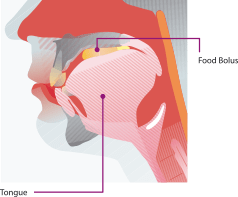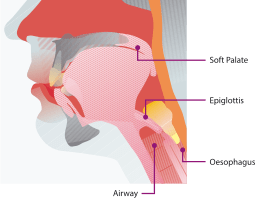This article is part 1 of 4-part series on dysphagia.
What is Dysphagia?
Dysphagia is the medical term used to describe swallowing problems. It is caused by any medical condition which affects the structure, strength and co-ordination of chewing and swallowing muscles.
This might be due to stroke, Parkinson’s disease, dementia, neurological conditions and mouth or oesophageal cancer. Dysphagia is also common in children or adults with developmental or learning disability.
Dysphagia can cause many problems including:
- Dehydration.
- Poor nutrition and weight loss.
- Coughing/choking episodes.
- Limited enjoyment of food.
- Anxiety at meal times.
- Isolation from social activities where food is involved.
- Chest infections from inhaled food or liquid.
How do I recognise dysphagia?
If you or anyone you know has signs of the following they may be having difficulty with swallowing:
- Coughing or clearing the throat at meal times.
- Food residue left in the mouth after a swallow.
- Difficulty chewing or moving food around the mouth.
- Loss of liquid from the mouth when drinking.
- Difficulty holding food in the mouth or initiating a swallow.
- Wet or gurgling voice after eating or drinking.
Dysphagia is a serious medical condition, for which you must seek advice from a suitable medical practitioner.
Normal Swallowing
The normal swallow has four phases:
1) Oral Preparatory:
Food is taken into the mouth and is mechanically chewed, this stimulates salivary production. Chewing mixes the food with saliva to start the process of digestion.
2) Oral Phase:
Food is gathered up by the tongue to form a bolus, ready to be propelled to the back of the throat. The tongue moves the bolus upwards and backwards. This triggers the start of the involuntary swallow.
 3) Pharyngeal Phase:
3) Pharyngeal Phase:
This is an involuntary or automatic response. The soft palate raises to close off the nose. As food moves through into the pharynx the epiglottis closes o the airway and food is propelled into the oesophagus.
4) Oesophageal Phase:
Peristaltic movement of the oesophagus squeezes food down into the stomach.
Part 2 of this series – ‘Dysphagia – Diagnosis and Treatment’ – looks at how dysphagia is diagnosed and treated. Click here to read it now.




 3) Pharyngeal Phase:
3) Pharyngeal Phase: